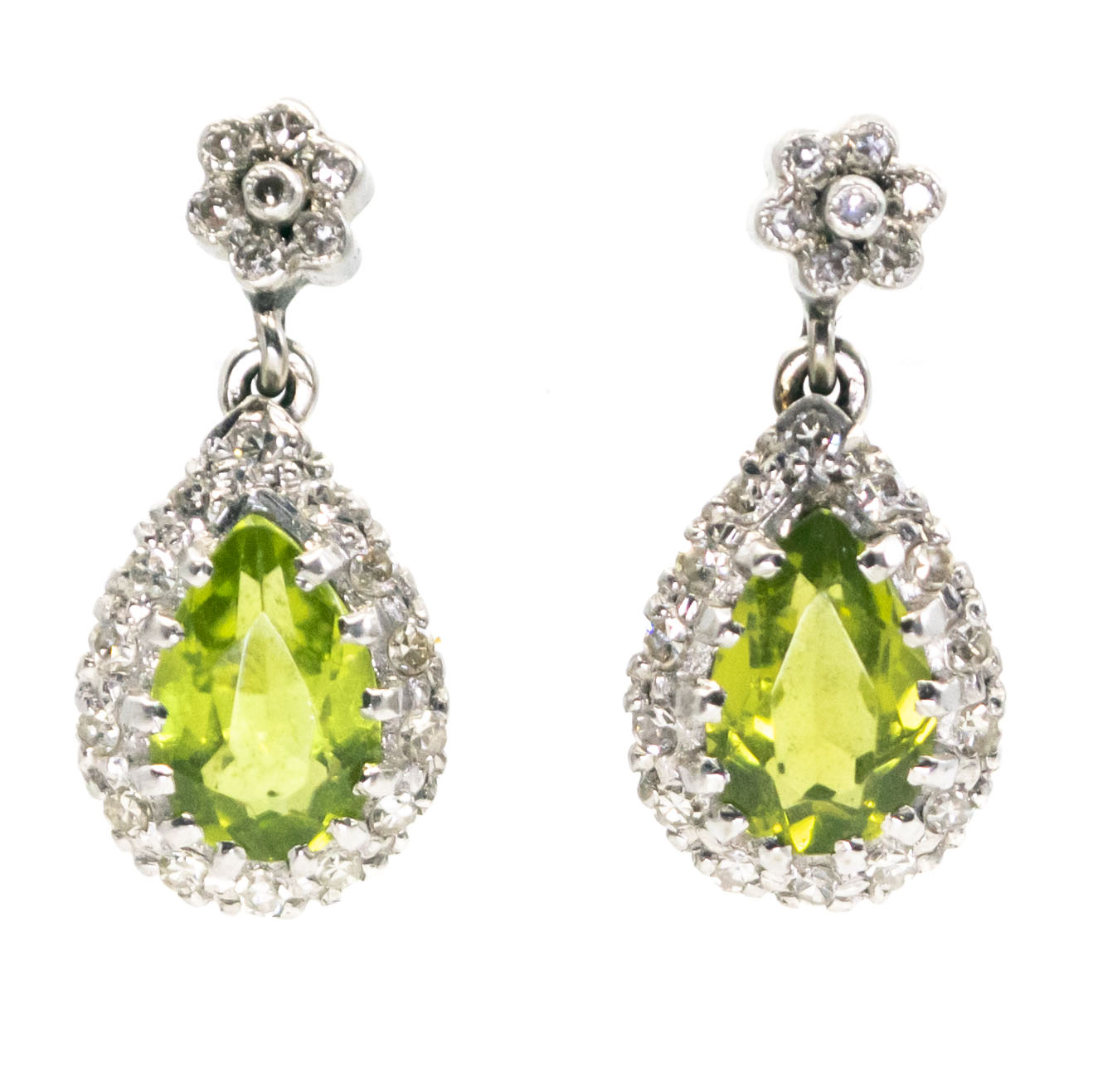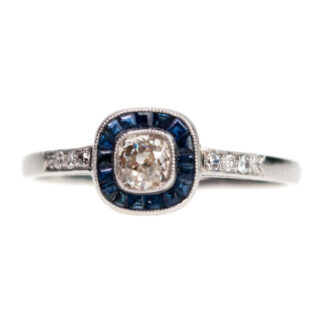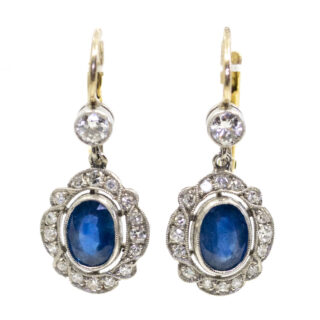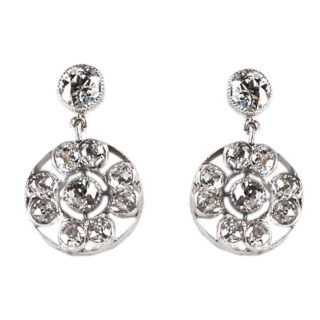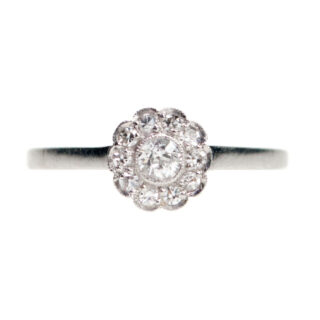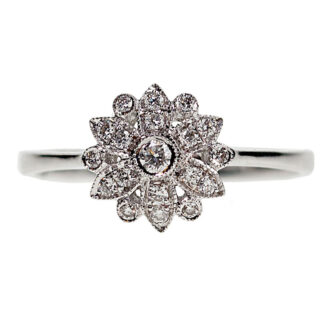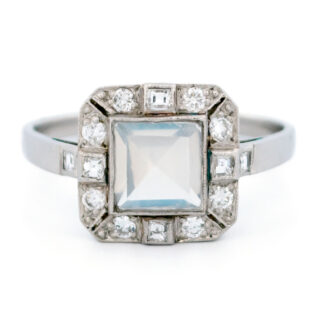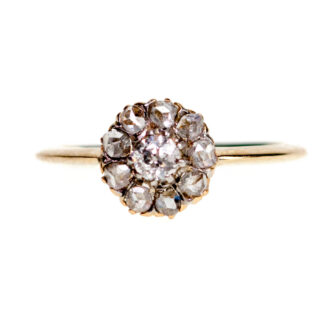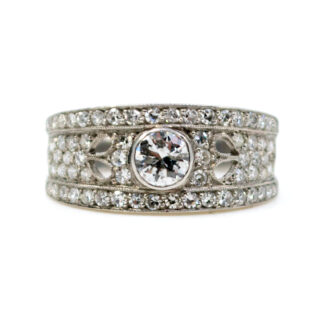Revel in retro glamour with these gorgeous 1935-1950 pendant earrings. Each exquisite earring showcases a stunning pear-shaped peridot, weighing at an estimated 1.50ct, beautifully surrounded by an approximate 0.25ct of K-L S1 single-cut diamonds, all crafted in 14k gold.
Details: ±1.50ct Peridots, ±0.25ct (K-L S1) Single-cut diamonds, 14k Earrings *.
Design Era: Retro (1935-1950).
Dimensions: H 2 x L 0.7 x W 0.6 cm.
Weight in grams: 4.
Condition: Very good condition – slightly used with small signs of wear.
Shipping and Pickup: This stunning piece ships from our store located in the center of Amsterdam, The Netherlands. We offer both registered shipping and local pickup at our store. In the case of local pickup, any applicable shipping costs will be refunded.
About Us: Add some sparkle to your style with Binenbaum.com. We offer a stunning selection of antique and vintage jewelry that you won’t find anywhere else. From timeless rings and dazzling necklaces to unique brooches, we have something for every taste and occasion. Visit our website today and treat yourself to a piece of history.
| Design Era | |
|---|---|
| Design & Historical Context | The jewelry industry was significantly impacted by the onset of World War II in the 1940s. Precious metals, particularly platinum, became scarce and in some cases were even banned from being sold. Palladium was used as a substitute for platinum in the war effort. In order to make the most of the limited supply of gold, a low karat gold alloy with a higher percentage of copper was used. This resulted in gold with a subtle, reddish hue, but through the use of different alloys, gold was able to appear in a range of colors within a single piece. Gold was also manipulated in various ways, such as being woven, braided, and coiled. Techniques like resilla, cannetille, and lacy filigree patterns reappeared in jewelry. Different textures were also used within a single design, with matte finishes being placed next to bright finishes to accentuate the design. Gold became the primary metal used in jewelry during the 1940s and 1950s. |
| Key Materials | |
| Materials & Craftsmanship | Peridot Peridot is a gemstone that is made up of the mineral forsterite. It is known for its bright golden green color, which is caused by the presence of iron in the crystal structure of the mineral. Peridot has been prized for its exceptional color since ancient times, and it has been used in jewelry for thousands of years. Peridot became especially popular during the Victorian era, when it was a favored stone in jewelry. It reached the height of its popularity during the aesthetic period of the Victorian era and the reign of Edward VII of England, who is said to have designated peridot as his favorite gemstone. Many different schools of art and design incorporated peridot into their work during this time, including the Pre-Raphaelites, the Arts and Crafts movement, Art Nouveau, and those working in the Edwardian style. Peridot is found in a few different locations around the world, including the United States, Brazil, and China. It is a relatively hard and durable gemstone, and it is often used in a variety of different types of jewelry, including rings, earrings, and pendants. Despite its popularity, peridot is not as well known as some other gemstones, and it is often overlooked in favor of more familiar stones like diamonds and emeralds. Single-cut diamond A single cut diamond is a type of diamond cut that was popular in the 1300s and is still used today in some antique jewelry. It is characterized by a large table, an octagonal girdle, and a culet (the bottom edge of the diamond) that may be pointed or flat. Single cut diamonds usually have 18 facets, which are small, flat surfaces that are cut into the diamond to create a specific shape and enhance its sparkle and brilliance. Single cut diamonds are usually smaller in size and less brilliant than modern diamond cuts, such as round brilliant or princess cuts. They are often used in antique jewelry or as accent stones in modern jewelry designs. Single cut diamonds are typically less expensive than diamonds with more modern cuts because they require less labor and material to produce. Despite their lower price, single cut diamonds can still be beautiful and valuable. They are a popular choice for collectors of antique jewelry and for those who appreciate the timeless beauty of vintage cuts. 14k 14k gold is a popular choice for use in jewelry because it is durable, yet still relatively affordable compared to higher karat golds like 18k or 24k. It is made up of 58.5% pure gold and is mixed with other metals to make it harder and more durable. 14k gold is available in a range of colors, including yellow, white, and rose, and is commonly used in a variety of jewelry pieces such as rings, earrings, necklaces, and bracelets. One of the advantages of 14k gold is that it is more resistant to wear and tear than pure gold, which makes it suitable for everyday wear. However, it is still softer than other alloys such as stainless steel or platinum, so it may require more maintenance to keep it looking its best. Overall, 14k gold is a popular choice for those who want the look and feel of gold, but at a more affordable price point. |
| Dimensions | H 2 x L 0.7 x W 0.6 cm |
| Gender | |
| Weight (in grams) | 4 |
| Condition | Very good condition – slightly used with small signs of wear |
Enhance the Beauty of Your Jewelry with Proper Care
Wearing your jewelry is a special way to express yourself and add a touch of personal style to any look. However, to ensure your jewelry remains in pristine condition, there are a few simple steps you need to take to keep it looking its best.
General Care Instructions:
Remove jewelry when showering or bathing, especially when at the beach, in the sea or in chlorinated water.
Avoid wearing jewelry while doing physical work such as housekeeping, gardening or exercise.
Storing your jewelry in a dry and cool place will help protect it from moisture, dirt and dust.
Keeping it away from harsh chemicals such as bleach, ammonia and chlorine will help to avoid discoloration and damage.
Cleaning your jewelry regularly with a soft cloth will help to keep it looking shiny and new.
Avoid exposing your jewelry to extreme temperatures, such as leaving it in direct sunlight or near a heater, as this can cause damage.
Handle your jewelry carefully and avoid dropping it, as this can cause the stones to loosen or the metals to scratch.
Finally, if possible, have your jewelry professionally checked and serviced. This will ensure that any potential problems are spotted and fixed before they become worse.
By following these tips, you can enjoy your precious jewelry for many years to come.
Related products
-
Diamond Sapphire Platinum Target Ring 6988-0010
€ 2.295,00 VAT incl. (where applicable) -
Diamond Sapphire Platinum 18k Pendant Earrings 4503-4685
€ 3.795,00 VAT incl. (where applicable) -
Diamond Platinum Pendant Earrings 5846-0616
€ 3.595,00 VAT incl. (where applicable) -
Diamond Platinum Cluster Ring 5651-4767
€ 1.695,00 VAT incl. (where applicable) -
Diamond 18k Cluster Ring 7035-0694
€ 1.395,00 VAT incl. (where applicable) -
Moonstone Diamond Platinum Square-Shape Ring 4489-4682
€ 2.995,00 VAT incl. (where applicable) -
Diamond 14k Cluster Ring 6898-1835
€ 1.395,00 VAT incl. (where applicable) -
Diamond Platinum Ring 5208-4734
€ 4.695,00 VAT incl. (where applicable)
- Home
- Collection
- Fine Jewelry
- Silver Jewelry
- Silverware
- Boxes
- Candlesticks
- Salt and pepper shakers
- Miniatures
- Salt cellars
- Spoon Set
- Condiments
- Frames
- Napkin Ring
- Spoon
- Oddities
- Cups
- Vases
- Cutlery
- Serving Spoon And Cake Server
- Candlesticks
- Baskets
- Hanukkiah
- Spice Tower
- Yad
- Tea Set
- Sugar Castor
- Napkin Rings
- Wine Bottle Coaster
- Wine Stopper
- Tea Pot
- Jugs
- Rattles
- Hip Flask
- Miscellaneous
- Rings 💍
- About
- Contact
